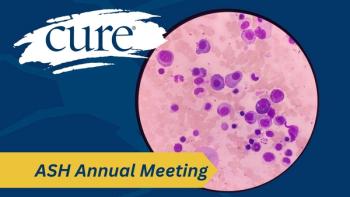
First-in-Class Drug Preserves Blood Counts During Chemotherapy for Lung Cancer
Given with each dose of chemotherapy, trilaciclib temporarily puts bone marrow to sleep, helping to prevent fevers, infections and hospital stays in patients with small cell lung cancer.
Given with each dose of chemotherapy, administration of trilaciclib may temporarily put bone marrow to sleep, helping to prevent fevers, infections and hospital stays in patients with small cell lung cancer, according to study findings presented at the 2019 American Society of Clinical Oncology (ASCO) Annual Meeting.
Side effects from chemotherapy often include nausea, vomiting and hair loss, but there are other side effects — related to blood health — that may be less familiar to patients. Chemotherapy can cause myelosuppression, a decrease in bone marrow activity that can lead to a drop in the levels of white and red blood cells, as well as a decrease in platelets, leaving patients vulnerable to infection, fevers and bleeding.
Therefore, Dr. Lowell Hart, scientific director of clinical research at Florida Cancer Specialists and associate professor at the Wake Forest School of Medicine in North Carolina, and colleagues have set out to improve tolerability to Hycamtin (topotecan) — the only approved chemotherapy for patients with small cell lung cancer who have progressed following initial treatment.
The researchers tested whether an experimental drug, trilaciclib, can be given along with the chemotherapy to protect bone marrow, helping to prevent these side effects. At the meeting, Hart sat down with CURE® to discuss the findings.
CURE®: Please describe the toxicities associated with chemotherapy, specifically myelosuppression.
Hart: Chemotherapy is still a mainstay of treatment in many cancer types, and one of the major toxicities we see is
Trilaciclib is the first in a new class of drugs. Please tell us more about it.
Trilaciclib is an intravenous inhibitor of (the proteins) CDK4 and 6. It inhibits cells that are sensitive to it from going through the cell cycle — sort of temporarily puts them to sleep, in lay terms. (Essentially, we are using trilaciclib to) anesthetize the marrow right before chemotherapy to protect it from the adverse effects of the treatment — but it continues to grow, and then it wakes up.
What were the goals of the trial?
It was a phase 2, randomized, double-blind trial of the only second-line chemotherapy that is (Food and Drug Administration)-approved for this setting: topotecan, which I’ve used in patients for 20 years and is well-tolerated except that it often makes blood counts go in the tank. I’ve often had to make adjustments in dose and (timing) to get the treatment in, so I felt it was an ideal scenario to study.
Patients in one arm got topotecan alone and in the other got topotecan plus trilaciclib given just before each dose. The endpoint was the occurrence of severe neutropenia (a deficiency of neutrophils, a type of white blood cell), because that’s most damaging to the patient and most likely to bring them into the hospital needing antibiotics. Sometimes people die from that and from sepsis, and we’re trying to avoid that. So, the most important endpoints were the occurrence of any severe neutropenia in the first cycle, and the duration of that. We did allow them to get GSCF (a growth factor) and erythropoiesis-stimulating agents (which stimulate the bone marrow to make more red blood cells) after the first cycle if they needed it.
The trial did meet the primary endpoints: There was less severe neutropenia and less duration (of it) in the trilaciclib arm. There were trends in the same direction for red cells and platelets, but they were not as dramatic as with white cells; that would be expected, because white cells are proliferating the most rapidly.
What was the key takeaway from the trial?
It was proof of principle that, in this preliminary study, you were able to use a myelopreservation agent, which has never been released before in intravenous form, and be able to protect bone marrow from some of the toxicities from chemotherapy.
What is your hope for how this agent might be applied in practice?
Chemotherapy is not going away, at least not in the next 30 to 40 years. In tumors like small cell lung cancer and triple-negative breast cancer, chemotherapy remains the foundation of treatment for patients with advanced disease, and ovarian cancer is also a pretty chemo-sensitive disease. These results could let us give more frequent adequate dosing of second-line chemotherapy. But the big benefit I potentially see from trilaciclib is combining it with checkpoint inhibitors and chemotherapy to potentiate the effects of the checkpoint inhibitors and preserve against some of the adverse effects of chemotherapy. It possibly would be a win-win. It’s a hypothesis, but it’s potentially where I see the future of the drug.
We’re doing studies now in earlier-stage patients with their initial treatment for
What are the unknowns with trilaciclib?
When it’s developed, will it be for a broad class of patients to protect bone marrow from the effects of (all kinds of) chemotherapy, or only in one tumor type with one particular chemotherapy? The drug works but finding the proper space for it is the main thing.
Why are these results meaningful to patients?
As oncologists, we’re trying to pay more attention to the patients and their quality of life. We found no difference in how long patients lived or how often cancer shrank, but quality of life was better when we (used trilaciclib) in our study. In the big picture, what really matters is quality of life being maintained on treatment. If they end up miserable and in the hospital, treatment may not be worth it to the patient.





